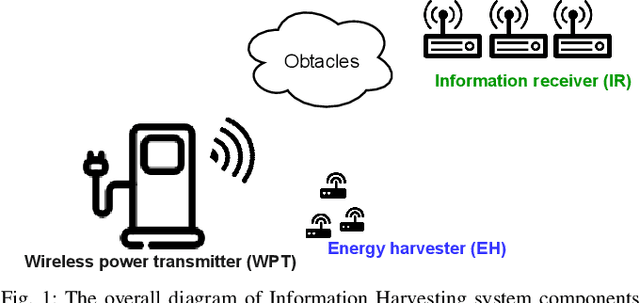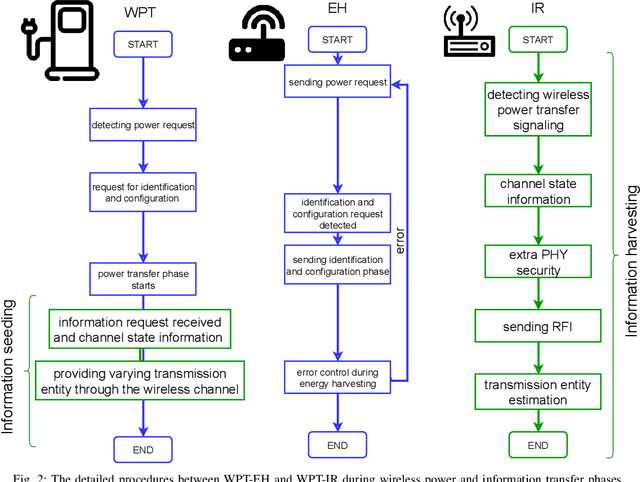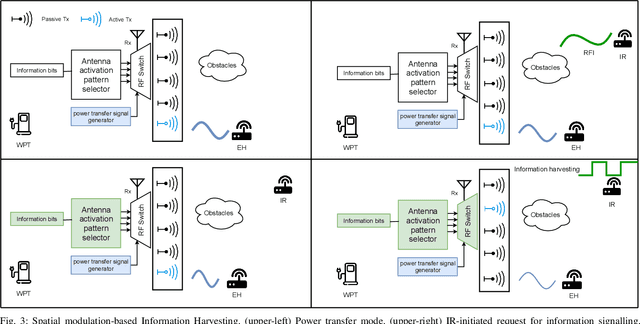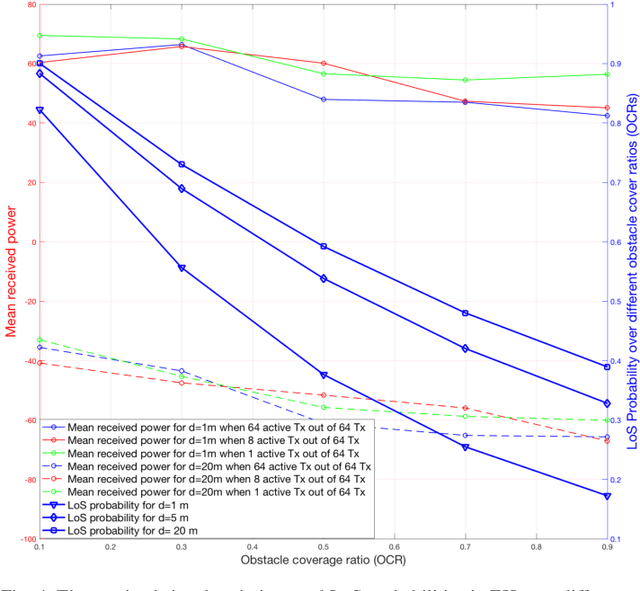Jyri Hämäläinen
Index Modulation-based Information Harvesting for Far-Field RF Power Transfer
Sep 24, 2023Abstract:While wireless information transmission (WIT) is evolving into its sixth generation (6G), maintaining terminal operations that rely on limited battery capacities has become one of the most paramount challenges for Internet-of-Things (IoT) platforms. In this respect, there exists a growing interest in energy harvesting technology from ambient resources, and wireless power transfer (WPT) can be the key solution towards enabling battery-less infrastructures referred to as zero-power communication technology. Indeed, eclectic integration approaches between WPT and WIT mechanisms are becoming a vital necessity to limit the need for replacing batteries. Beyond the conventional separation between data and power components of the emitted waveforms, as in simultaneous wireless information and power transfer (SWIPT) mechanisms, a novel protocol referred to as information harvesting (IH) has recently emerged. IH leverages existing WPT mechanisms for data communication by incorporating index modulation (IM) techniques on top of the existing far-field power transfer mechanism. In this paper, a unified framework for the IM-based IH mechanisms has been presented where the feasibility of various IM techniques are evaluated based on different performance metrics. The presented results demonstrate the substantial potential to enable data communication within existing far-field WPT systems, particularly in the context of next-generation IoT wireless networks.
UAV-based Maritime Communications: Relaying to Enhance the Link Quality
Apr 17, 2023Abstract:Providing a stable connectivity in maritime communications is of utmost importance to unleash the full potential of smart ports. Nonetheless, due to the crowded nature of harbor environments, it is likely that some ships are shadowed by others, resulting in reduced received power that subsequently diminishes their data rates-even threatens basic connectivity requirements. Given that UAVs have been regarded as an integral part of future generations of wireless communication networks, they can be employed in maritime communications as well. In this paper, we investigate the use of UAV-mounted relays in order to help mitigate the reduced data rates of blocked links in maritime communications. Various communication architectures are considered based on the positioning mechanism of the UAV; in this regard, fixed, k-means algorithm-based, and landing spot-based positioning approaches are examined. On the other hand, since UAVs are predominantly battery-operated, the energy consumption performances of these approaches are also measured. Results reveal that the landing spot-based UAV relay positioning approach finds the best trade-off between the data rate and energy consumption.
A canonical correlation-based framework for performance analysis of radio access networks
Sep 29, 2022



Abstract:Data driven optimization and machine learning based performance diagnostics of radio access networks entails significant challenges arising not only from the nature of underlying data sources but also due to complex spatio-temporal relationships and interdependencies between cells due to user mobility and varying traffic patterns. We discuss how to study these configuration and performance management data sets and identify relationships between cells in terms of key performance indicators using multivariate analysis. To this end, we leverage a novel framework based on canonical correlation analysis (CCA), which is a highly effective method for not only dimensionality reduction but also for analyzing relationships across different sets of multivariate data. As a case study, we discuss energy saving use-case based on cell shutdown in commercial cellular networks, where we apply CCA to analyze the impact of capacity cell shutdown on the KPIs of coverage cell in the same sector. Data from LTE Network is used to analyzed example case. We conclude that CCA is a viable approach for identifying key relationships not only between network planning and configuration data, but also dynamic performance data, paving the way for endeavors such as dimensionality reduction, performance analysis, and root cause analysis for performance diagnostics.
Resource Allocation in a Quantum Key Distribution Network with LEO and GEO trusted-repeaters
Jul 15, 2021



Abstract:Quantum Key Distribution~(QKD) is a technology that enables the exchange of private encryption keys between two legitimate parties, using protocols that involve quantum mechanics principles. The rate at which secret keys can be exchanged depends on the attenuation that is experienced. Therefore, it is more convenient to replace many terrestrial fiber segments (and repeaters) by just few optical satellite links that would enable flexible global coverage. Then, the satellite nodes can take the role of trusted-relays, forwarding the secret keys from source to destination. However, since the rate at which secret keys can be generated in each quantum link is limited, it is very important to select the intermediate satellite nodes to inter-connect ground stations efficiently. This paper studies the most convenient allocation of resources in a QKD network that combines complementary connectivity services of GEO and LEO satellites. The aim of the centralized routing algorithm is to select the most convenient trusted-relays to forward the secret keys between pairs of ground stations, verifying the constraints that satellite-to-ground and inter-satellite quantum channels have.
Information Harvesting for Far-Field Wireless Power Transfer
May 26, 2021



Abstract:Considering ubiquitous connectivity and advanced information processing capability, huge amount of low-power IoT devices are deployed nowadays and the maintenance of those devices which includes firmware/software updates and recharging the units has become a bottleneck for IoT systems. For addressing limited battery constraints, wireless power transfer is a promising approach such that it does not require any physical link between energy harvester and power transfer. Furthermore, combining wireless power transfer with information transmission has become more appealing. In the systems that apply radio signals the wireless power transfer has become a popular trend to harvest RF-radiated energy from received information signal in IoT devices. For those systems, design frameworks mainly deal with the trade-off between information capacity and energy harvesting efficiency. Therein various signaling design frameworks have been proposed for different system preferences between power and information. In addition to this, protecting the information part from potential eavesdropping activity in a service area introduces security considerations for those systems. In this paper, we propose a novel concept, Information Harvesting, for wireless power transfer systems. It introduces a novel protocol design from opposite perspective compared to the existing studies. Particularly, Information Harvesting aims to transmit information through existing wireless power transfer mechanism without interfering/interrupting power transfer.
Visible light communication-based monitoring for indoor environments using unsupervised learning
Jan 20, 2021Abstract:Visible Light Communication~(VLC) systems provide not only illumination and data communication, but also indoor monitoring services if the effect that different events create on the received optical signal is properly tracked. For this purpose, the Channel State Information that a VLC receiver computes to equalize the subcarriers of the OFDM signal can be also reused to train an Unsupervised Learning classifier. This way, different clusters can be created on the collected CSI data, which could be then mapped into relevant events to-be-monitored in the indoor environments, such as the presence of a new object in a given position or the change of the position of a given object. When compared to supervised learning algorithms, the proposed approach does not need to add tags in the training data, simplifying notably the implementation of the machine learning classifier. The practical validation the monitoring approach was done with the aid of a software-defined VLC link based on OFDM, in which a copy of the intensity modulated signal coming from a Phosphor-converted LED was captured by a pair of Photodetectors~(PDs). The performance evaluation of the experimental VLC-based monitoring demo achieved a positioning accuracy in the few-centimeter-range, without the necessity of deploying a large number of sensors and/or adding a VLC-enabled sensor on the object to-be-tracked.
 Add to Chrome
Add to Chrome Add to Firefox
Add to Firefox Add to Edge
Add to Edge